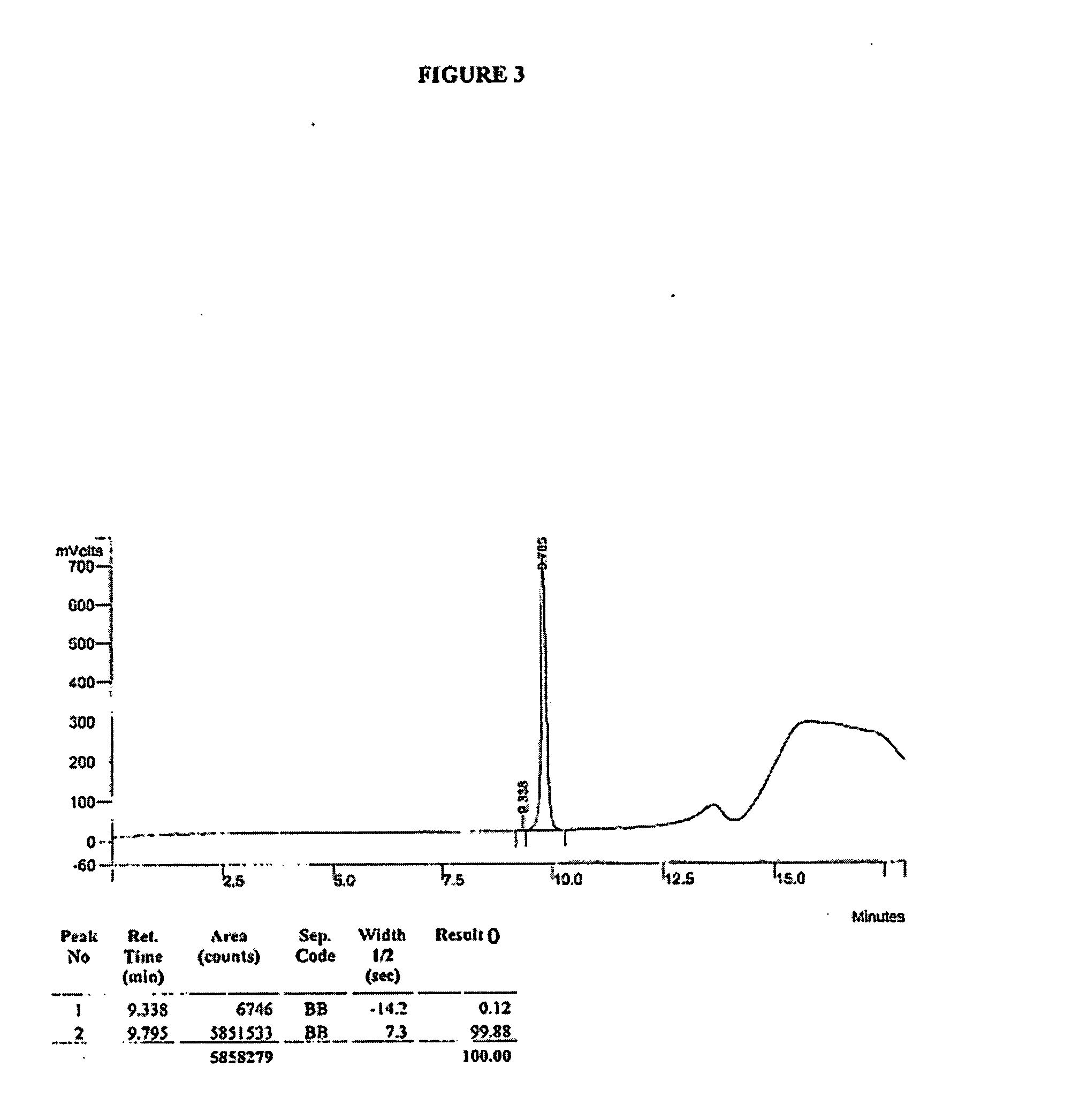Synthesis of R-N-methylnaltrexone
a technology of r-n-methylnaltrexone and synthesis, which is applied in the direction of organic active ingredients, material analysis, inorganic non-active ingredients, etc., can solve the problems of inaccurate methods, achieve the effects of reducing gastric emptying, promoting gastrointestinal motility, and reducing constipation
- Summary
- Abstract
- Description
- Claims
- Application Information
AI Technical Summary
Problems solved by technology
Method used
Image
Examples
example 1
HPLC Analysis of R- and S-MNTX
[0187] HPLC analysis was performed on a Varian ProStar HPLC controlled by Varian Star software using the following method:
HPLC Method I:
Column: Luna C18(2), 150×4.6 mm, 5μ
Flow Rate: 1 mL / min
Detection: UV @ 230 nm
[0188] Gradient Program:
Time (min)% A% B 0:00955 8:00653512:00356515:00010016:0095518:00955
Mobile phase A = 0.1% Aqueous TFA
Mobile phase B = 0.1% Methanolic TFA
TFA = trifluoroacetic acid
HPLC Method II:
Chromatographic Conditions and Parameters: Analytical Column Description:
Phenomenex Inertsil ODS-3 150×4.6 mm, 5 μm Column Temperature: 50.0° C. Flow Rate: 1.5 mL / min Injection Volume: 20 μL Detection Wavelength: 280 nm Mobile Phase: A=Water: MeOH:TFA (95:5:0.1%; v / v / v) B=Water:MeOH:TFA (35:65:0.1%; v / v / v) Analysis Time: 50 min
Quantitation limit: 0.05%
Detection limit: 0.02%
[0189] Gradient Profile:
Time (min)% A% BCurve0:001000Initial455050Linear481000Linear551000Hold
Mobile Phase A (Water:MeOH:TFA::95:5:0.1%, v / v / v)
Mobile P...
example 2
Stereoselective Synthesis of R-MNTX
[0192] The synthetic scheme for Example 2 is shown in FIG. 6.
[0193] General. All anhydrous reactions were carried out in oven-dried (130° C.) glassware under an atmosphere of dry nitrogen (N2). All commercial reagents and solvents were used without any additional purification. Nuclear magnetic resonance (NMR) spectra were obtained using either a Varian Gemini or Varian Mercury 300 MHz spectrometer. Mass spectra were determined on a Finnigan LCQ. HPLC purity was determined using a Waters 717 Autosampler and Waters 996 Photodiode Array Detector.
[0194] 3-O-Isobutyryl-Naltrexone (2). To a solution of compound (1) (1.62 g, 4.75 mmol) in anhydrous tetrahydrofuran (THF) (120 mL) at 0° C. was added triethylamine (NEt3) (1.4 mL, 10 mmol). After the reaction was stirred for 15 min. at 0° C., isobutyryl chloride (1.05 mL, 10 mmol) was added dropwise. Reaction mixture was stirred at 0° C. for 1 hr, then at room temperature for 18 hr before being quenched wi...
example 3
Stereoselective Synthesis of R-MNTX
[0205] The synthetic scheme for Example 3 is shown in FIG. 7. In Example 3, the method taught by Goldberg et al for protecting groups was followed. Acetyl, Goldberg et al's preferred protecting group, instead of isobutyryl was used as the protecting group. The reactions were carried out as described in Example 2. It was surprisingly found using the scheme shown in FIG. 7 that the acetyl protecting group tended to fall off during purification of intermediate 2 (O-acetyl-naltrexone). This made it difficult to obtain pure intermediate 2. The yield of intermediate 2 with the acetyl group was only 36.3% rendering the scheme shown in FIG. 7 unsuitable for commercial scale-up. In contrast using the synthetic scheme with isobutyryl as the protecting group (FIG. 6), intermediate 2 (3-O-isobutyryl-naltrexone) was quite stable during purification resulting in a yield of 76.8%.
PUM
| Property | Measurement | Unit |
|---|---|---|
| temperature | aaaaa | aaaaa |
| temperature | aaaaa | aaaaa |
| pore size | aaaaa | aaaaa |
Abstract
Description
Claims
Application Information
 Login to View More
Login to View More - R&D
- Intellectual Property
- Life Sciences
- Materials
- Tech Scout
- Unparalleled Data Quality
- Higher Quality Content
- 60% Fewer Hallucinations
Browse by: Latest US Patents, China's latest patents, Technical Efficacy Thesaurus, Application Domain, Technology Topic, Popular Technical Reports.
© 2025 PatSnap. All rights reserved.Legal|Privacy policy|Modern Slavery Act Transparency Statement|Sitemap|About US| Contact US: help@patsnap.com



